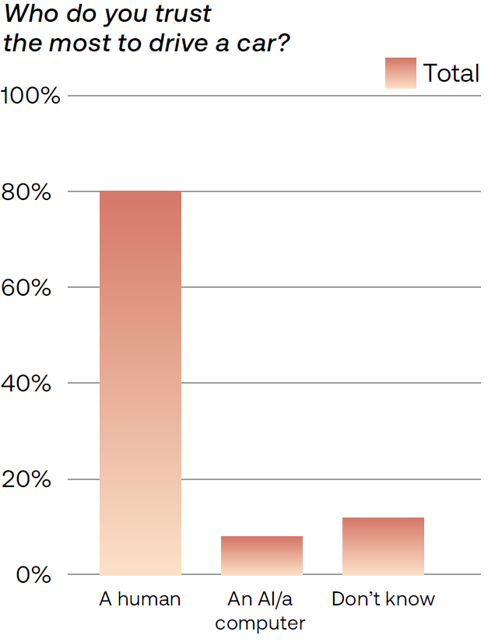In California, the Department of Motor Vehicles already issues permits to manufacturers for testing and deploying autonomous vehicles on public roads. In San Francisco, the sight of self-driving taxis has become a common element in the bustling cityscape. However, progress in Northern Europe has been somewhat slower. Challenging weather conditions and a perhaps more cautious outlook mean that this reality is still a few steps away.
Many in the Nordic countries seem to be hesitant about the new technology, according to the Mobility Barometer. A clear majority of 80 percent say they trust a human most to drive a car. Only 8 percent trust a computer or AI more, while 12 percent have no preference.
The general debate about autonomous driving has undoubtedly changed.
“Have we reduced our ambition, or have we become more realistic? A bit of both, unfortunately,” says Eren Erdal Aksoy, Associate Professor at Halmstad University in Sweden. “A while ago, there were many overpromises and unrealistic visions about the future. I would even say that this technology and its promise are suddenly losing momentum. We’re not there yet."
The future potential
Eren Erdal Aksoy has extensive experience in AI from some of the largest automotive companies in Europe. As the Project Coordinator for the Horizon Europe research consortium ROADVIEW, he dedicates much of his time to researching self-driving vehicles and enhancing road safety.
He explains that instead of Level 5 autonomy, which represents fully automated driving, the technology we currently have is at Level 3, referred to as conditional driving automation. Despite efforts to temper expectations, Eren is keen to highlight the benefits and potential of this transformation. “Safety is the most important benefit. People are prone to errors. AI will probably drive smarter and safer, which will decrease the number of incidents on the road. It will also allow better sharing of vehicles, which means there are sustainability benefits to this,” he says.
An often-overlooked benefit
Another often overlooked aspect is that self-driving cars will broaden and democratize transportation. It will make vehicles more accessible to the elderly and people with disabilities. However, the digitalization of the industry extends beyond autonomous driving. Many envision a future with an increased focus on so called smart cities and smart mobility.
“Vehicles that are connected to traffic lights and able to communicate with each other will make transportation smarter and faster. The gains from connectivity are enormous, and this is one of the most exciting trends right now,” he says.
Several factors must be considered in this transformation, with regulations being a key concern. For instance, who will be held accountable in the event of an accident? As this technology continues to evolve, there are probably aspects that we do not know about. This, according to many, implies that we must approach it responsibly and regulate it accordingly.
The most critical aspect
Perhaps the most critical aspect of implementation is social acceptance. But we are not there yet, according to the Mobility Barometer.
Nearly one in three is negative about the general technological shift where AI is gradually taking over functions that were previously handled by the driver. This is the same proportion as those who are positive, with the remaining third being neither positive nor negative. The Danes are the most positive at 37 percent, followed by the public in Sweden (30), Norway (28) and Finland (27).
There are a few key factors to improve social acceptance, according to Eren Aksoy. One is that people feel involved, both in terms of regulations and more technically. As the attitude may differ between generations and regions, this transformation needs public support. To address these challenges, Eren emphasizes the importance of education and transparency.
“Many people have felt left behind during other tech shifts, which applies not only to autonomous driving but to AI more broadly. We must educate people about AI and demystify it. Another important innovation for autonomous driving is continuous interaction between the AI and passengers, where it explains its decisions and why it might choose an alternative route. This is crucial for enhancing social acceptance,” says Eren.
Even though most people trust human drivers more, there are differences between groups and countries. Men tend to trust a computer more than women do (11 compared to 5 percent), and individuals under 50 are more open to automated driving than those over 65 (13 compared to 4 percent). Additionally, people in Finland tend to trust a human driver slightly more than others: 86 percent have this view. This is higher than in Norway (81), Denmark (80), and Sweden (78).







